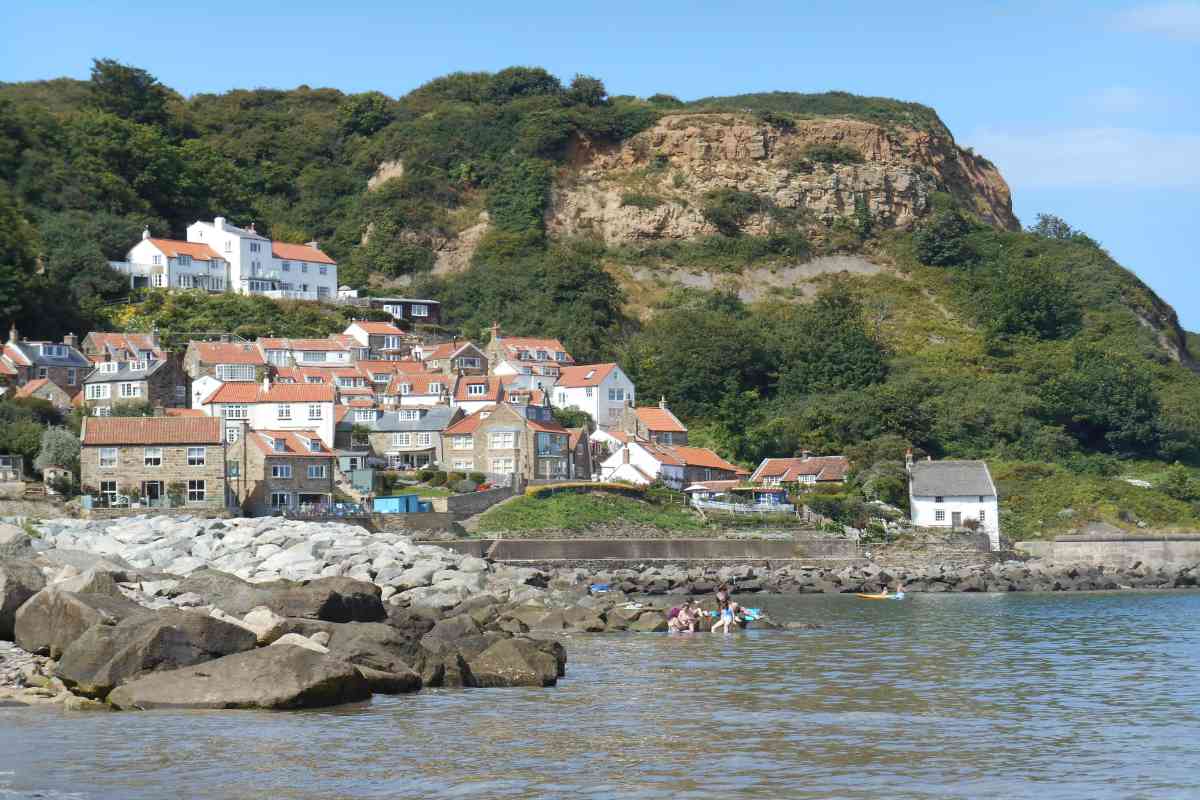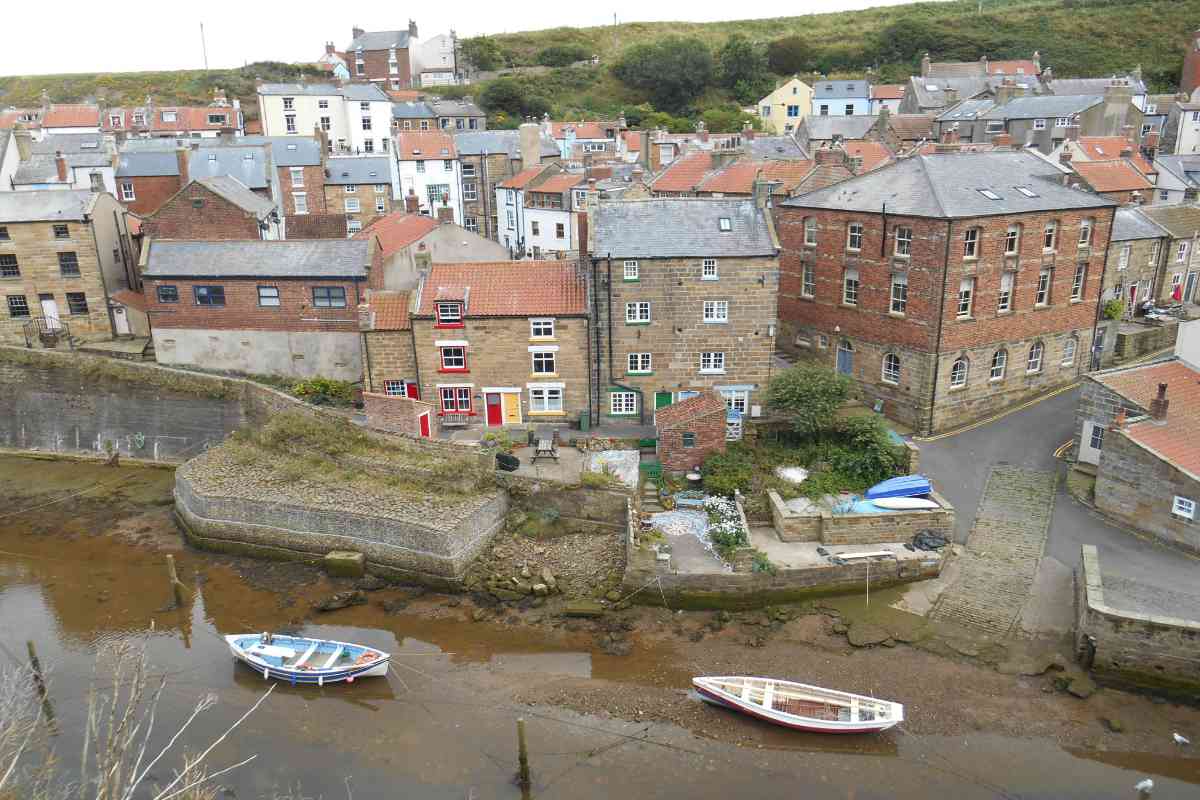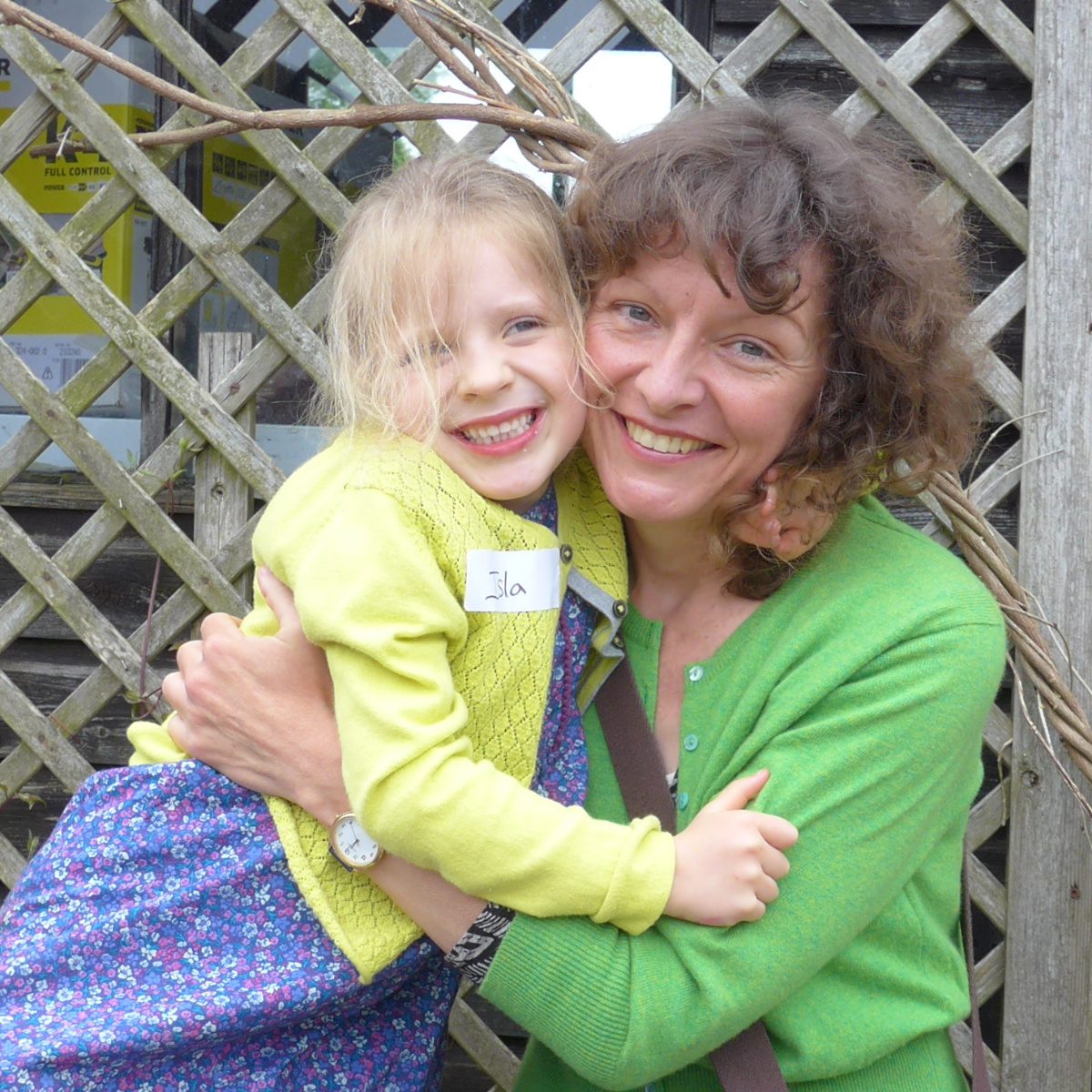After miles of undulating moorland Whitby comes as a surprise; in the words of James Herriot: “you almost tumble out of the heather into the town.” As we gingerly descend Blue Bank in second gear those magnificent, unmistakable ruins appear on the horizon: Whitby Abbey, silhouetted against a mackerel sky as the sun goes down over the North Sea.
In August, Whitby is a place of lively beaches and big skies, of waving golden grass and thistledown lit up by dramatic sunsets, of yellowhammers calling “a-little-bit-of-bread-and-no-cheese.” But everywhere there is evidence of the elements that batter this historic port at harsher times of year: the rust eating inexorably into anchors and railings, the gravestones in St Mary’s churchyard dissolving in salt-laden winds, their inscriptions no longer legible.
YHA Whitby is in a spectacular location, on the headland right next to the Abbey. A Victorian mansion restored in 2006 by English Heritage and YHA, it has beautiful communal spaces that include a conservatory, a large cafe that’s open to the public, and extensive gardens lovingly maintained for the benefit of pollinators and humans alike by a team of volunteers. There are views over the town in every direction, across allotments, meadows, and the estuary plied by fishing boats and pleasure craft.


We stayed in one of the two bell tents that are a new accommodation option this year. Arriving at dusk, there were bats flitting around the ancient walled garden where they are located and we could see how this atmospheric place inspired Bram Stoker whilst he was writing his Gothic novel Dracula, first published in 1897.
The tents, just like the ones we’d stayed at before in Cornwall and Pembrokeshire, were large and comfortable, and the self-catering kitchen and bathroom facilities excellent. The entrance to the garden opens on to the cobbled path at the top of the 199 steps that connect Whitby’s Old Town with Whitby Abbey. At some point most visitors make their way up them, among them many fantastically dressed aficionados of Steampunk, and Goths wearing the jet and silver jewellery for which the town is famous.

After a few days of climbing up and down – the ultimate step aerobics regime – our fitness increased to the point that we thought nothing of popping down to Marie Antoinette’s Patisserie (slogan: “Let them eat cake”) for some of their superlative cheese scones, warm from the oven. In Yorkshire, scones come in generous dimensions roughly twice the size of their southern counterparts; various local names reflect this.
We spent sunny days on Whitby’s West Cliff Beach, huge at low tide. The inevitable chips were provided by Mister Chips by the Beach and they kindly fried them in vegetable oil for us, rather than the traditional dripping. We flew our kite, collected sea glass, and explored the rock pools, then headed up the cliff path to a curvaceous Art Deco paddling pool which last year was renovated with colourful mosaics of sea creatures by local artist Jo Witney.


Sailor and explorer Captain James Cook learned his profession in Whitby and two of his most famous ships – Resolution and Endeavour – were built there. His statue surveys the sea from West Cliff, near the Whalebone Arch, surrounded by municipal island bedding schemes in unashamedly clashing colours.
We took day trips to the nearby picturesque fishing villages of Runswick Bay and Staithes, the latter the location for CBeebies’ Old Jack’s Boat, and walked three miles from Helmsley to the tranquil ruins of another abbey: the Cistercians’ Rievaulx. There’s an interesting new exhibition there about how the medieval monks dealt with water and sewage, including a stop cock in shape of an actual cockerel.


We also went to see the steam trains and walk through the honey-scented heather at Goathland, up on the moors. The station features in the first Harry Potter film. The North Yorkshire Moors Railway, which runs between Whitby and Pickering, is a great experience, but on this visit we tried an alternative: the Esk Valley Railway between Whitby and Middlesborough, which follows the valley of the River Esk and skirts the edge of the moors. It is a very scenic journey of one and a half hours each way and with a Family and Friends railcard only cost £15.20 return for all four of us.
Each of the 16 stations presented an interesting reason to get off and explore – the line could inspire an entire holiday – but with limited time we decided to stop just before Middlesborough, at Captain Cook’s birthplace, Marton, to visit the Palladian mansion of Ormesby Hall. A National Trust house, its gardens were bursting with blue agapanthus, and their Summer of Play was in full swing: archery with safe suction arrows was a particular hit, also hula-hooping. There’s an indoor model railway and a laundry room full of mangles and irons. In Stewart Park, near the station, is the Captain Cook Birthplace Museum; also a giant map of his circumnavigations and statues relating to the places he visited, including a slightly terrifying one from the South Seas in the children’s playground.

Back in Whitby, we used the free voucher we’d got from YHA reception to visit the Abbey, and were fortunate enough to be there for one of the wonderful summer promenade performances of Dracula by Time Will Tell theatre company. It was both funny and scary, and suitable for children of all ages. Anxious whimpering suggested the dogs in the audience could sense there was something not quite right about Count Dracula.
Our children also enjoyed the playground in Pannett Park and I went to the Museum and Art Gallery, where there is a collection of English impressionist paintings from the Staithes Group, including by Dame Laura Knight, and an archive of evocative sepia photos of everyday life in Whitby in the 19th century by Frank Meadow Sutcliffe. A temporary exhibition about female scientists included delicate cyanotypes of seaweed by marine biologist Jane Pottas, in tribute to the 19th century botanist and photographic pioneer Anna Atkins.
First thing in the morning and last thing at night the Radio Four announcer intones the Shipping Forecast: “Berwick-upon-Tweed to Whitby, Whitby to Gibraltar Point …” For us, Whitby is no longer just another name in a sonorous list; we have so many happy memories of this beautiful part of the world.
For more information:
YHA Whitby can provide maps for local walks from the door, including an introductory one around the town (about 5 miles), and one covering the coastal path south to Robin Hood’s Bay (14 miles as a circular walk, or 7 if you catch the bus back).
The Coastliner 840 bus operates from Leeds and York across the moors to Whitby.
Moorsbus, a community public transport initiative, is making it easier to explore North Yorkshire by bus in summer.
Yorkshire-based vet and author of All Creatures Great and Small James Herriot often spent family holidays on the North Yorkshire coast: James Herriot’s Yorkshire (Michael Joseph, 1979)
Read more of Jenny’s blogs.
Discover more about YHA.













